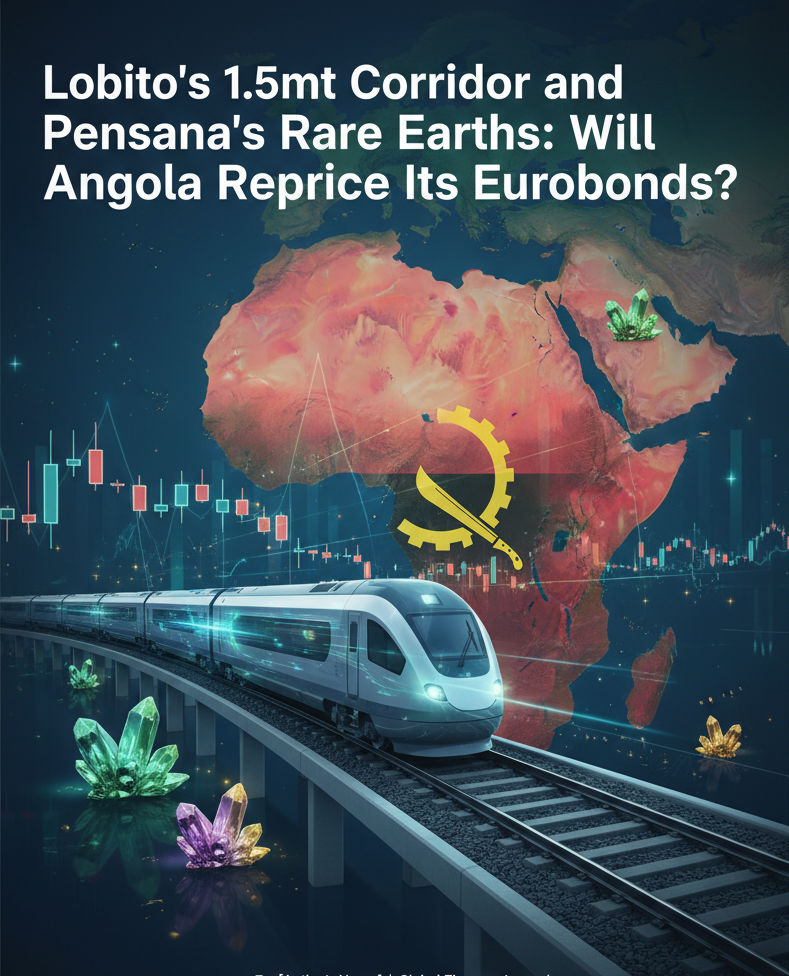Lobito’s 1.5mt Corridor and Pensana’s Rare Earths: Will Angola Reprice Its Eurobonds?
Angola eyes 17.5m carats by 2027, a $600m-carat Luele mine, and Pensana’s (LSE: PRE) 20–40ktpa rare earths (~5% global share). With Lobito Corridor aiming 1.5mtpa copper flows, sovereign Eurobonds (8.25% 2029, ~12% yield) could tighten if execution delivers.

Angola is attempting to pivot from its traditional oil-and-diamonds dependence to a diversified mineral economy that could eventually reshape its sovereign credit profile. The government has reorganized oversight, strengthening regulators such as the National Agency for Mineral Resources (ANRM) and restructuring Endiama and Sodiam to improve transparency. Diamonds remain the anchor, with Catoca supplying over 60% of output, but the commissioning of the Luele kimberlite has changed the scale of the game. With more than 600 million carats in reserves and an estimated sixty-year mine life, Luele is projected to double national production capacity. The government’s target of 17.5 million carats by 2027 would place Angola as the world’s third-largest producer, behind Russia and Botswana. The challenge remains demand volatility. In 2025, softer midstream appetite forced stockpiling even as “special stones” fetched $57.8 million at auction, underscoring the cyclical nature of diamond revenues.
The more strategic pivot is into critical minerals. Pensana (LSE: PRE) is advancing the Longonjo rare earths project, with guidance of ~20,000 tonnes per year of mixed rare-earth carbonate from late 2026 and an expansion to ~40,000 tonnes by 2027, equivalent to about 5% of global supply. With ore reserves grading 3.04% TREO and a multi-decade mine life, Longonjo could make Angola Africa’s first large-scale NdPr producer. The risk lies in financing, execution, and rare-earth price volatility, but the scale is sufficient to attract offtake interest from global OEMs seeking non-Chinese supply streams.
The Lobito Corridor is arguably the most transformative element. This ~1,300 km Atlantic-facing rail and port system, concessioned to a consortium led by Trafigura and Mota-Engil, is backed by a $533 million U.S. Development Finance Corporation loan alongside $320 million from Africa Finance Corporation and Italian partners. It aims to move 40,000 tonnes of copper-cobalt per month by 2026 and 1.5 million tonnes annually within a decade. For global supply chains, this diversifies export routes away from DRC’s congested road corridors and Indian Ocean ports, reducing basis risk for deliveries to Europe and the U.S. If throughput materializes, Lobito’s cargo scale would be equivalent to several mid-tier mines in volume.
For exploration, Angola has also attracted new commitments. De Beers, part of Anglo American (LSE: AAL), re-entered the country in 2022 and announced in 2025 its first kimberlite discovery in three decades. This validates reforms to licensing and contract enforcement, showing Angola can draw major capital back into greenfield projects.
The economic implications extend beyond commodity flows. Angola’s GDP is around $122 billion, with oil still accounting for more than half and diamonds another 10%. External debt sits at ~65% of GDP, while Eurobonds such as ANGOL 8.25% 2029 yield roughly 12% in secondary markets. That level reflects lingering fiscal stress and investor doubts about diversification. A credible ramp-up of mining receipts could provide a stabilizing effect on external balances, reduce debt service risks, and strengthen the case for sovereign spread compression relative to Sub-Saharan peers. In a bull case, where diamonds reach 17.5 million carats, Longonjo delivers 40,000 tonnes of rare earths, and Lobito sustains over 1 mtpa copper throughput, Angola could secure billions in incremental export earnings. This would lift reserves, strengthen the kwanza, and support fiscal consolidation. Eurobond yields could compress by 200–300 basis points if investors see consistent project execution translating into fiscal space. In a base case, with slower ramp-ups and cyclical headwinds in diamonds or rare earths, spreads may stay elevated. In a bear case, execution delays or policy reversals would confirm Angola as another unrealized diversification story, keeping borrowing costs punitive.
The risks are significant. Diamond markets remain cyclical, rare earth projects globally have struggled with timely delivery, and large-scale infrastructure such as Lobito carries risks of overruns and tariff disputes. Angola’s mining code provides a clearer framework than a decade ago, but predictable enforcement and contract sanctity will determine the cost of capital. Execution at both project and policy level is the pivot point for whether Angola’s Eurobond curve reprices lower or remains locked in double-digit yields.
The critical analysis is that Angola is assembling the building blocks for a minerals re-rating: a supersized diamond resource, Africa’s first large-scale rare earths project, and an Atlantic export corridor for copper and cobalt. For equity investors, Pensana (LSE: PRE) and Anglo American (LSE: AAL) offer direct exposure, while Trafigura’s involvement signals private credit and structured trade opportunities. For sovereign debt investors, the mining drive is no longer just about commodities; it is about credit resilience. If execution matches ambition, Angola could reduce its reliance on hydrocarbons, lift fiscal revenues, and tighten spreads on Eurobonds currently priced as distressed risk. If not, it risks staying locked in a cycle of aspirational announcements with little impact on credit markets.





